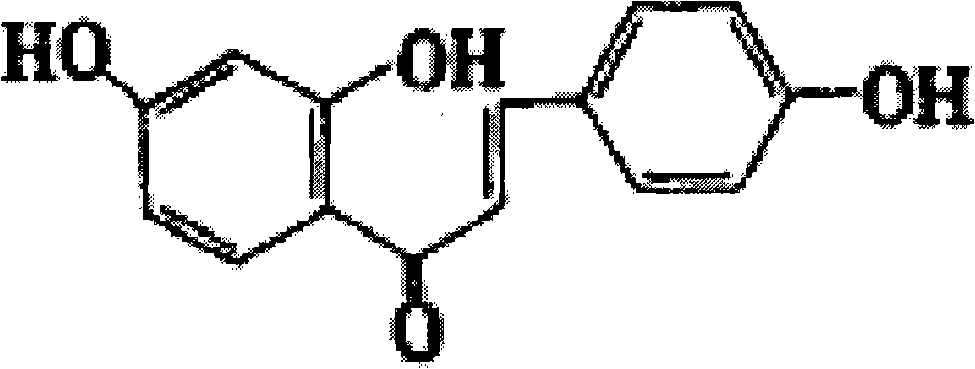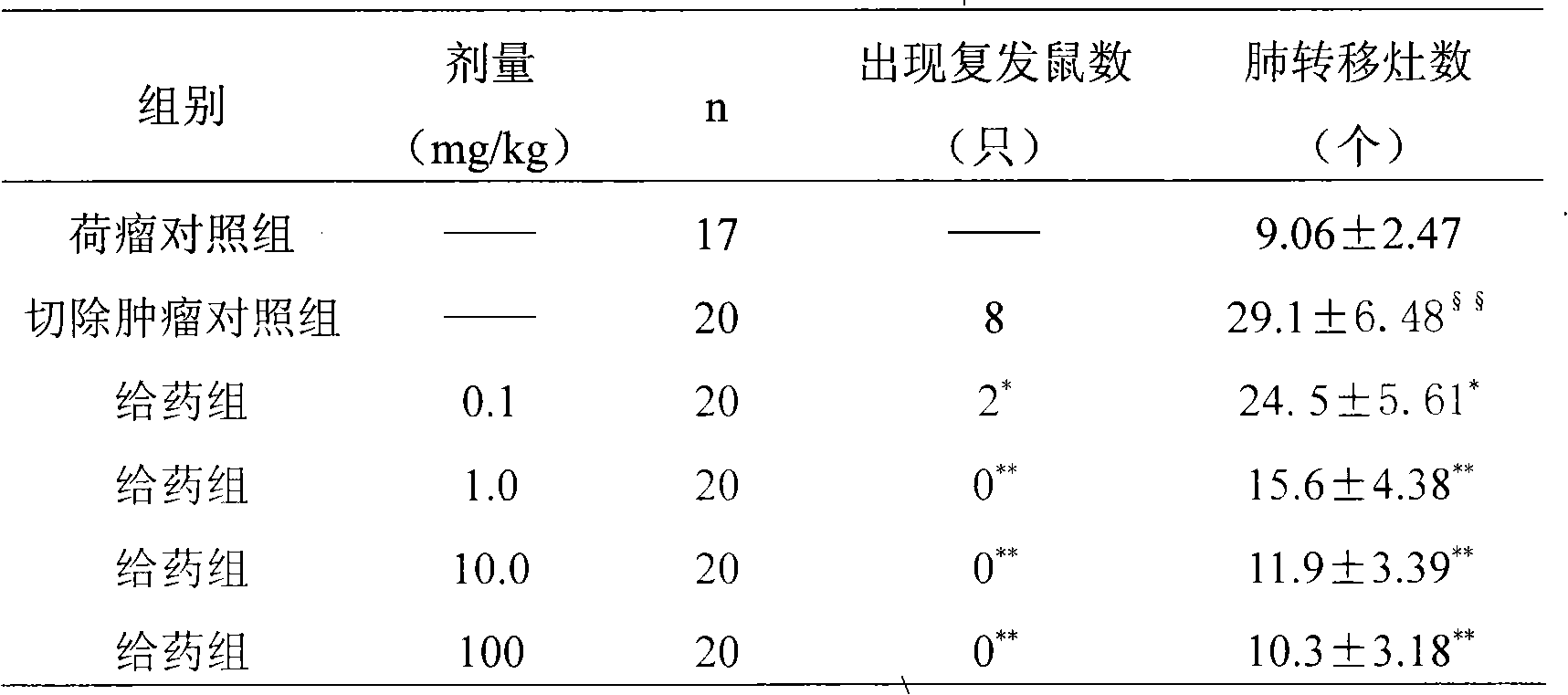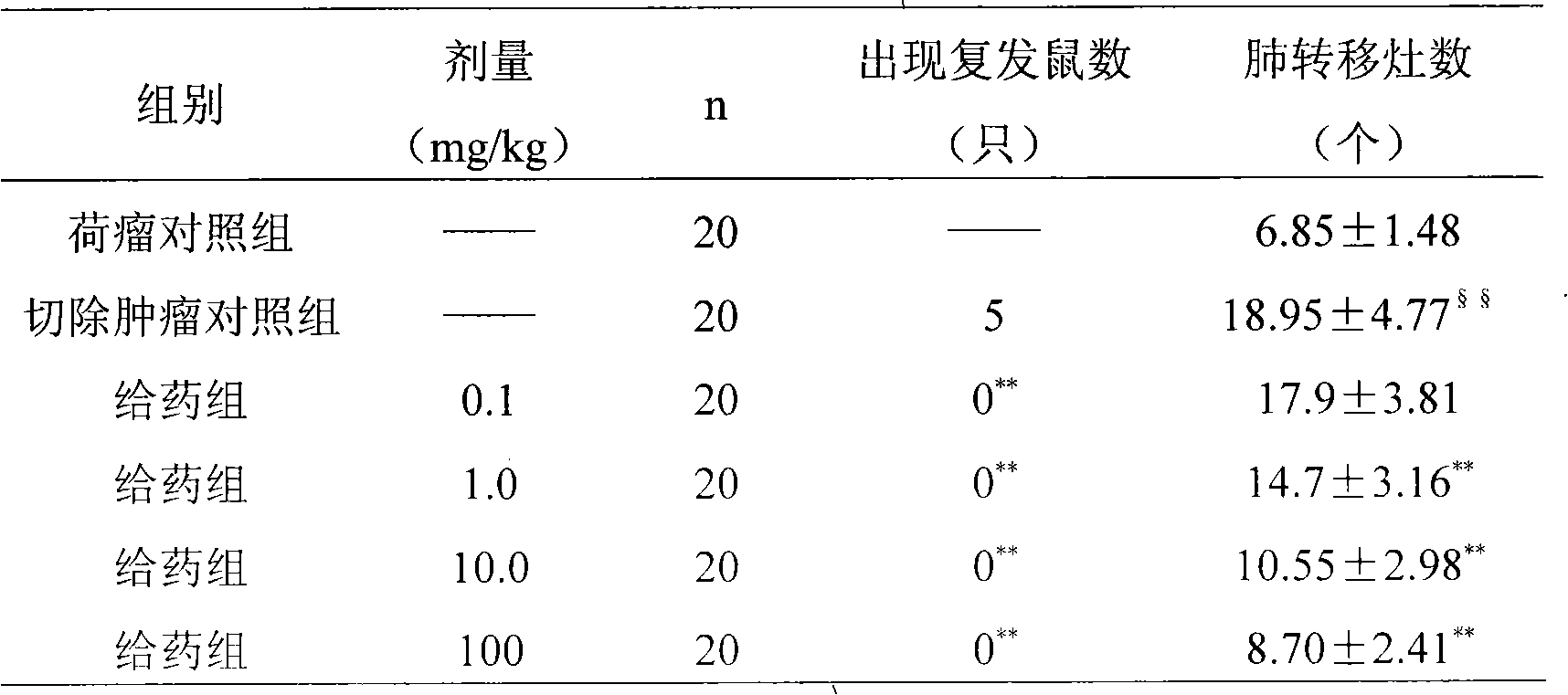Use of isoliquiritigenin as medicament for preventing and treating or curing postoperative metastasis and relapse of malignant tumors
A technology of isoliquiritigenin and malignant tumors, applied in the field of medicine, can solve the problems not involved in the application of isoliquiritigenin to inhibit tumor recurrence and metastasis, and achieve the effect of inhibiting tumor recurrence and metastasis with low cost
- Summary
- Abstract
- Description
- Claims
- Application Information
AI Technical Summary
Problems solved by technology
Method used
Image
Examples
experiment example 1
[0021] Experimental example 1 Effect of isoliquiritigenin on recurrence and metastasis of melanoma after surgical resection
[0022] Isoliquiritigenin was purchased from Jiangxi Bencao Tiangong Technology Co., Ltd., and its purity was 99.8% as determined by HPLC. The mouse B16F10 melanoma highly metastatic cell line was purchased from the China Center for Type Culture Collection. The cells were stored in DMEM medium containing 10% fetal bovine serum, 100 U / ml penicillin, and 100 μg / ml streptomycin at 37°C, 5% CO 2 Under the conditions of cultivation, the culture medium was changed every 24 hours, and the culture medium was subcultured every 3 days.
[0023] Take the cells in the logarithmic growth phase, digest with trypsin, and adjust the concentration to 1×10 with the above-mentioned complete culture solution. 7 / ml of single cell suspension, subcutaneously inject 0.1ml of tumor cell suspension into the left axilla of C57BL / 6 mice, and inoculate 150 mice in total. After 2 ...
experiment example 2
[0028] Experimental Example 2 Effect of Isoliquiritigenin on Recurrence and Metastasis after Surgical Resection of Primary Tumor of Lung Cancer
[0029] The mouse Lewis lung cancer cell line was purchased from Beijing Institute of Materia Medica, Chinese Academy of Medical Sciences, and the cells were inoculated subcutaneously in the axilla of C57BL / 6 mice. At the time of passaging, the tumor-bearing mice that had been inoculated with tumors for two weeks and had good tumor growth without ulceration were sacrificed by neck dislocation. After soaking in 75% alcohol for disinfection, the tumor pieces were aseptically stripped and cut into 1mm pieces. 3 Large and small lumps, in order of 20 #The puncture needle was inoculated subcutaneously in the axilla of C57BL / 6 mice, and a total of 150 mice were inoculated. After 2 weeks, 120 mice with tumor masses greater than 0.5 cm in length and diameter were selected and randomly divided into 6 groups, 20 mice in each group. One group w...
experiment example 3
[0034] Experimental example 3 Effect of isoliquiritigenin on recurrence and metastasis of human liver cancer after surgical resection of primary tumor
[0035] The experimental method refers to the literature [Xu Bing, Yao Ming, Gu Weiwang, et al. Establishment of an animal model of postoperative metastasis of human cancer and its biological characteristics. Journal of Southern Medical University. 2007; 27(7): 1009-11.].
[0036] The highly metastatic human liver cancer cell line LCI-D20 was purchased from the American Type Culture Collection (ATCC), and inoculated in SPF grade BALB / c-nu / nu nude mice for subcutaneous passage.
[0037] Take out subcutaneous xenografted tumors of tumor-bearing nude mice subcutaneously, immerse them in physiological saline containing 100 U / ml of penicillin and streptomycin, select tumor tissues that grow well, have no necrosis, and are fish-like, and cut them into about 1mm 3 The small pieces were transplanted subcutaneously into BALB / c-nu / nu nud...
PUM
 Login to View More
Login to View More Abstract
Description
Claims
Application Information
 Login to View More
Login to View More - R&D
- Intellectual Property
- Life Sciences
- Materials
- Tech Scout
- Unparalleled Data Quality
- Higher Quality Content
- 60% Fewer Hallucinations
Browse by: Latest US Patents, China's latest patents, Technical Efficacy Thesaurus, Application Domain, Technology Topic, Popular Technical Reports.
© 2025 PatSnap. All rights reserved.Legal|Privacy policy|Modern Slavery Act Transparency Statement|Sitemap|About US| Contact US: help@patsnap.com



